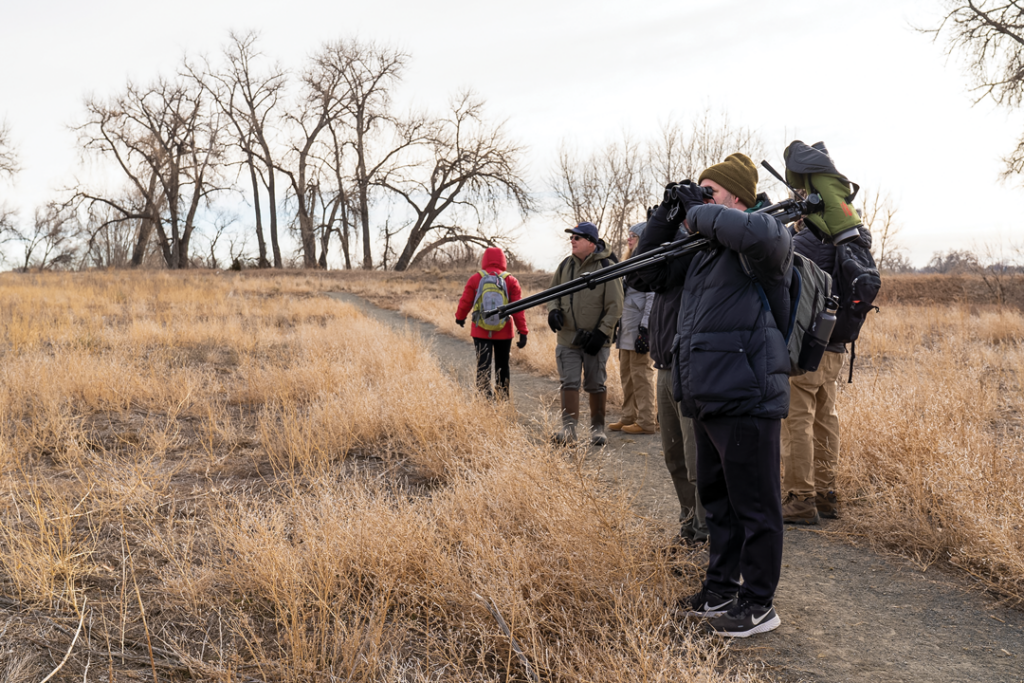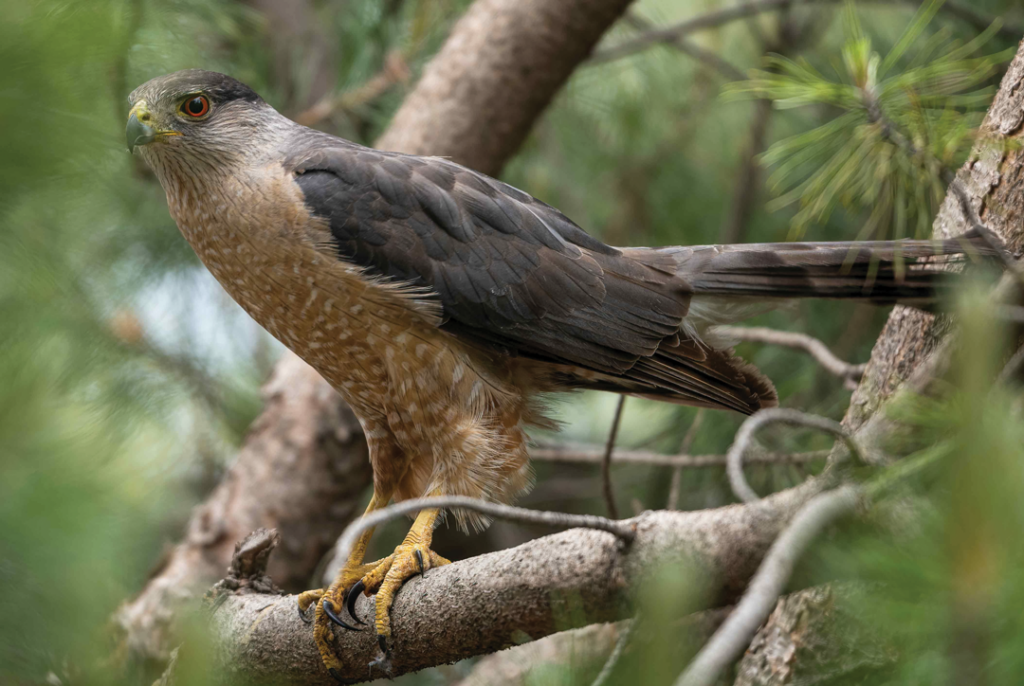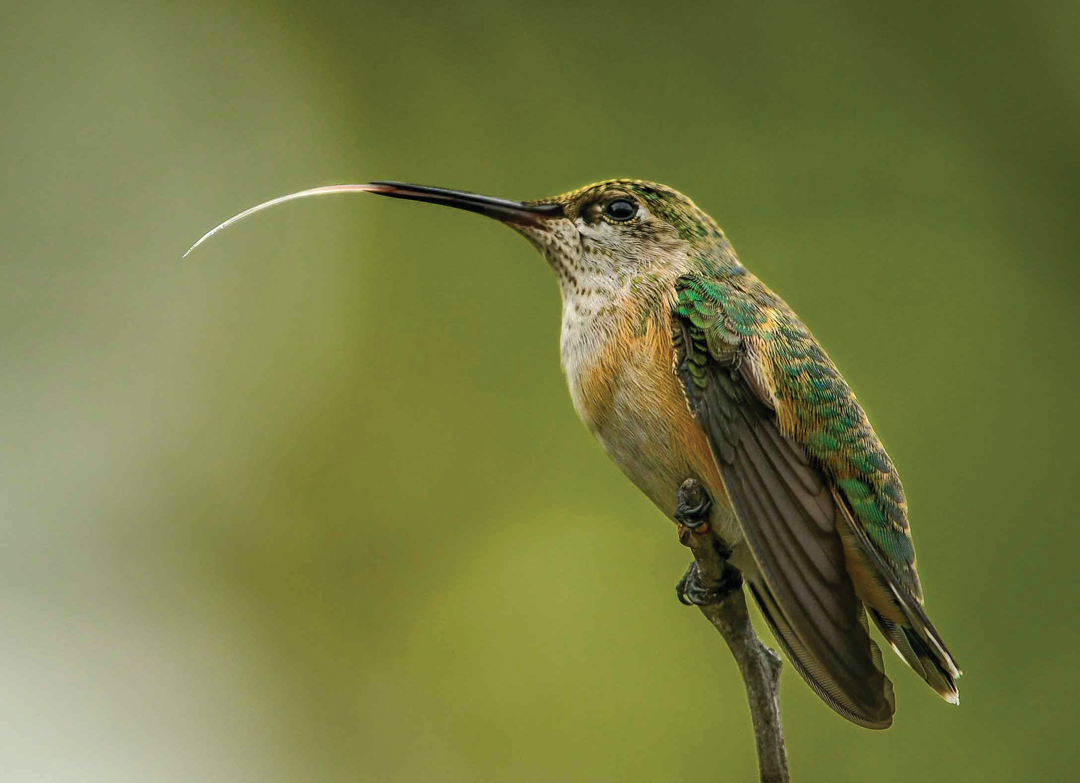If you’ve ever walked the Poudre River Trail following a wild bird’s trill and wondered what species was singing, you may be one of the many people who make birding one of the fastest growing activities in the country.
“We’re fascinated by birds because they do something we can’t: they fly,” says Carin Avila, executive director of the Rocky Mountain Raptor Program, a raptor rehabilitation and conservation organization in Fort Collins. “It’s their beauty, their songs, the feathers, the intricacies of their courtships and pair bonding. Birds aren’t that different from humans. They want a safe place to raise their families.”
Northern Colorado is full of birding destinations that vary by species and season, but generally both winter and spring are great times to see these feathered friends.

Volunteers survey birds for the 2023 Boulder Christmas Bird Count. Photo by ©️Evan Barrientos/Audubon.
Winter birding
Raptor species can be seen year-round, even during the colder months. Bald eagles like to spend their winters here, and other birds of prey make regular appearances in natural areas. Avila describes eagles, falcons, red-tailed hawks, American kestrels and the nocturnal great horned owl as “gateway birds” because they’re impressive and lead people to notice other birds.
“Many raptors have adapted to urban living,” Avila says. “You’ll see them in neighborhoods, cemeteries, golf courses and edges of open spaces. If you’re not sure whether a bird is a raptor, look for a large bird with a sharp, hooked beak and taloned feet.”
Though raptors remain active in the cold, winter birding can pose a challenge since fewer other birds are visible than in the summer. They’re also quieter.
“Birds don’t sing in winter; it’s mostly to defend and establish breeding territories and attract a mate,” says Evan Barrientos, senior communications manager for Audubon Rockies. “In winter, the focus is finding food and staying warm.”
Nuthatches, black-capped chickadees and Townsend’s solitaires are several species that make Northern Colorado their habitat year-round.
All kinds of wild birds are attracted to open bodies of water, including the Poudre River, Fossil Creek Reservoir (which hosts bald eagle viewings), Pelican Lakes and other Water Valley lakes in Windsor. Flowing waters attract waterfowl such as mergansers, a type of diving duck, and smaller birds, like western meadowlarks.
Megan Jones Patterson, an avian ecologist and membership chair of Colorado Field Ornithologists (CFO), a nonprofit supporting the birding community, says ducks and geese that congregate on the water in the winter are great subjects for novice birders because they stay still longer.
If you’re lucky, you might spot a snowy owl, a unique winter species that periodically migrates from its breeding grounds in the Arctic tundra, according to Peter Gent, a climate scientist and chairman of the Colorado Bird Records Committee of CFO who is considered one of Colorado’s premier birders. He says snowy owl appearances here depend on Arctic food supply; the owls feed on lemmings, which have cycles of sudden population declines.
“When the lemmings crash, the food supply comes down and the owls come down into the U.S.,” he says.
Winter is also when Audubon’s Christmas Bird Count happens (mid-December through mid-January), an annual event in which volunteers are assigned locations for counting. The tradition has been alive for 124 years, and over time, it has amassed valuable data, making it the longest community science project in the U.S., Jones Patterson says.
“It’s a nice tradition to meet other birders and explore an area you might not have birded in,” Barrientos says. “Birding is a great way to destress and be out in nature. Counting birds is meditative, allowing you to focus on what you’re hearing and seeing.”

A Cooper’s hawk in a Greeley backyard. Photo by John Adams.
Spring: Colorado’s peak birding season
Seeing birds in the spring is easier. Birds are everywhere, though popular birding spots continue to be near water. The trails are also more accessible and easier to navigate in the spring, Barrientos says.
Many birds seen in the spring and summer in Colorado are migrating through the state after summering in South America or the southern states. Others fly through on their way north to the Arctic. Bluebirds, hummingbirds, warblers and all manner of swallows (tree, violet-green and barn swallows, to name a few) are also in flight. In the summer, osprey overlap bald eagle territories because they eat fish, Avila says.
A special area for spring birding is the Pawnee National Grassland. The best time to visit the grassland is late May through June, Gent says, because in the winter it’s cold and bare, and the summers are hot and dry. If you go on a day-long birding excursion with CFO leaders, you might be rewarded with sightings of rare eastern birds, like the small, colorful warblers that migrate north through Colorado to breed in the Boreal forest of Canada.
“If they get bad weather in Colorado, they’ll set down and feed for a day and then they’re off again,” Gent says. “By early June, they’re attending their young.”
Birding tours of the grassland highlight roads where you might see three species that exclusively breed there: mountain plover, chestnut-collared longspur and thick-billed longspur. You can go on your own or with CFO leaders who are highly experienced birders and know where to find these birds. Costs vary, from nothing to about $25 per person.

Common Goldeneye, Photo by©️Evan Barrientos/Audubon.
Effects of climate change
Even rare bird species can be seen in the spring. Gent says he finds one or two a year. A new bird to Colorado is the limpkin, a marsh bird from Florida that feeds on snails and has had a dramatic expansion north over the past five years.
The limpkin is one of 10-12 species appearing in Southern Colorado for the first time. Gent associates the cause with a warming climate. He’s also sighted fewer northern species, like the rough-legged hawk, because the permanent snow line has retreated. It’s the biggest change he’s seen in his more than 47 years birding in Colorado.
“The new birds coming from the south indicate a warming climate. The birds are changing their habitats and have to fly farther north to breed. Birds that like cold weather are getting their habitats squeezed,” Gent says.
Avila believes the biggest challenge is habitat loss as humans continue to take up spaces where wild animals live.
“We’re seeing birds moving out of historic ranges because a field they were in was mowed down for housing, for example,” she says. “They need food, water, shelter, air and space to survive. Birds—like the canary in the coal mine—indicate the health of our environment.”
Unlike other animals, most birds can fly to a higher habitat, Jones Patterson says, but after reaching the mountaintop, there’s nowhere higher to go. Whatever they’re feeding on, often insects, are also shifting their habitat range or hatching earlier. “The question is whether the timing of those elements is happening at once,” she says.
“Climate change shifts the peak of food availability earlier, before migrating birds get here,” Barrientos says. “We’re seeing migration shifting earlier, but it’s not keeping up with the shifts of plants and insects.”
____________________________________________________________________________________________________________________________________
Create a Backyard Bird Habitat

American house finch (top bird)
with American goldfinches. Photo courtesy of Wild Birds Unlimited.
Make your yard bird-friendly by providing resources as they migrate or look for a breeding spot. Audubon Rockies’ Habitat Hero program recommends planting native, flowering plants to attract food sources, including insects, as well as berry bushes. Water is also essential.
Kyle Carlsen, manager and education coordinator for Wild Birds Unlimited, says anyone with a little space, from an apartment balcony to a five-acre yard, can attract birds.
He recommends buying quality birdseed and placing feeders at varying heights, with some close to the ground and others five feet high or in a tree. Different seeds attract different species, he says, so start with sunflower seeds to bring in a variety of birds, then add thistle for finches and peanuts for chickadees, nuthatches, woodpeckers, blue jays, magpies and crows. In the winter, suet gives birds much-needed fat to stay warm, and in the spring and summer, fruit and nectar draws additional species such as orioles, tanagers and hummingbirds.
Having trees and shrubs helps birds shelter from predators, he says, and a fresh, clean water source is a bird magnet. “Little birds are used to bathing in a shallow puddle, and a fountain or drip that keeps water moving attracts a bird’s attention. Heaters in the winter keep the temperature above freezing so it doesn’t ice over.”







